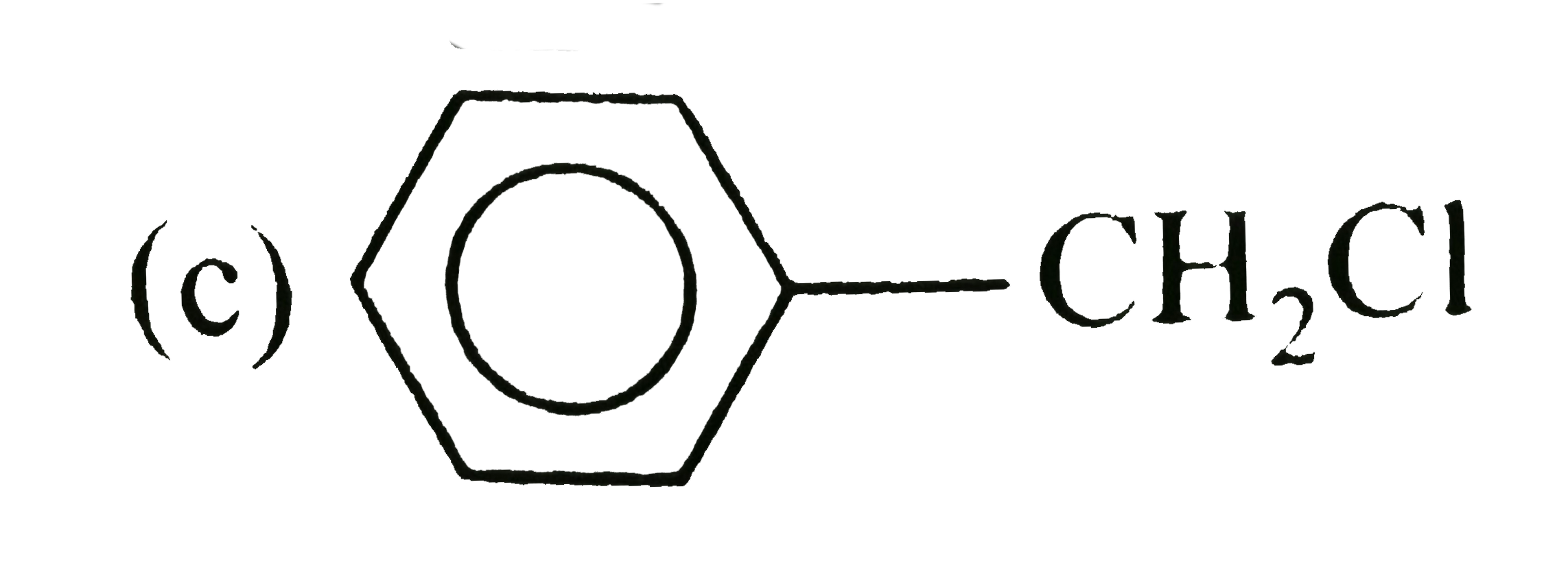Which will not give a white ppt with AgNO3?
Allyl chloride
Vinyl chloride
Chlorobenzene
Both (2) and (3)
The correct Answer is:D
To determine which compound will not give a white precipitate with AgNO₃, we need to analyze the reactivity of the halogen in each compound. The formation of a white precipitate (AgCl) occurs when a halogen (Cl⁻) is released and reacts with Ag⁺ ions. Let's evaluate the options step by step.
Step 1: Analyze Allyl Chloride
1. Structure: Allyl chloride has the structure CH₂=CH-CH₂Cl.
2. Reactivity: The chlorine atom is attached to the carbon adjacent to a double bond (allylic position).
3. Mechanism: When allyl chloride reacts with AgNO₃, the chlorine can leave as Cl⁻, forming a stable allylic carbocation (CH₂=CH-CH₂⁺).
4. Precipitate Formation: The Cl⁻ can then react with Ag⁺ to form AgCl, which is a white precipitate.
Conclusion: Allyl chloride will give a white precipitate with AgNO₃.
Step 2: Analyze Vinyl Chloride
1. Structure: Vinyl chloride has the structure CH₂=CHCl.
2. Reactivity: The chlorine atom is attached directly to a carbon that is part of a double bond (vinylic position).
3. Mechanism: When vinyl chloride reacts, the Cl atom cannot leave easily because the resulting carbocation (CH₂=CH⁺) is unstable.
4. Precipitate Formation: Since the carbocation is not stable, Cl⁻ will not be formed, and thus it cannot react with Ag⁺ to form AgCl.
Conclusion: Vinyl chloride will not give a white precipitate with AgNO₃.
Step 3: Analyze Chlorobenzene
1. Structure: Chlorobenzene has the structure C₆H₅Cl.
2. Reactivity: The chlorine atom is bonded to a benzene ring, which is a stable aromatic system.
3. Mechanism: The C-Cl bond in chlorobenzene is strong and does not undergo nucleophilic substitution easily. The chlorine does not leave as Cl⁻.
4. Precipitate Formation: Since Cl⁻ is not formed, it cannot react with Ag⁺ to produce AgCl.
Conclusion: Chlorobenzene will also not give a white precipitate with AgNO₃.
Final Answer
The compounds that will not give a white precipitate with AgNO₃ are Vinyl Chloride and Chlorobenzene. Therefore, the correct answer is option D (both 2 and 3).
---
1. Structure: Allyl chloride has the structure CH₂=CH-CH₂Cl.
2. Reactivity: The chlorine atom is attached to the carbon adjacent to a double bond (allylic position).
3. Mechanism: When allyl chloride reacts with AgNO₃, the chlorine can leave as Cl⁻, forming a stable allylic carbocation (CH₂=CH-CH₂⁺).
4. Precipitate Formation: The Cl⁻ can then react with Ag⁺ to form AgCl, which is a white precipitate.
1. Structure: Vinyl chloride has the structure CH₂=CHCl.
2. Reactivity: The chlorine atom is attached directly to a carbon that is part of a double bond (vinylic position).
3. Mechanism: When vinyl chloride reacts, the Cl atom cannot leave easily because the resulting carbocation (CH₂=CH⁺) is unstable.
4. Precipitate Formation: Since the carbocation is not stable, Cl⁻ will not be formed, and thus it cannot react with Ag⁺ to form AgCl.
1. Structure: Chlorobenzene has the structure C₆H₅Cl.
2. Reactivity: The chlorine atom is bonded to a benzene ring, which is a stable aromatic system.
3. Mechanism: The C-Cl bond in chlorobenzene is strong and does not undergo nucleophilic substitution easily. The chlorine does not leave as Cl⁻.
4. Precipitate Formation: Since Cl⁻ is not formed, it cannot react with Ag⁺ to produce AgCl.
The compounds that will not give a white precipitate with AgNO₃ are Vinyl Chloride and Chlorobenzene. Therefore, the correct answer is option D (both 2 and 3).
Similar Questions
Knowledge Check
The halides which will not gives ppt. with AgNO3 :
A B
B C
C D
D
Which will give white ppt.with AgNO3 ?
A .B
.B .C
.C .DBoth (a) and (c)
.DBoth (a) and (c)(A) C7H14 an organic compound decolourises Br2 solution to produce (B) which combines with strong base NaNH2 to produce (C) which does not give white ppt. with AgNO3/NH4OH. (A) again when treated with Hg(OAc)2/H2O+NaBH4 to produce (D) and when treated with HBr/ROOR then OH^(-) to produce (E). Here (D) and (E) are isomeric alcohol, one is optically acetic and other is optically inactive.
Q. What is (A)AC−C−C−C∣C=C−CBC−C−C−C∣∣C−C−CCC−C−C∣∣C∣C−C−CDC−C−C∣∣C−BrC−C−C
Which of the following will give white ppt. with aq.AgNO3 ?
View SolutionWhich one of the following will give a white precipitate with AgNO3 in aqueous medium
View SolutionWhich of the organic compounds will give white precipitate with AgNO3?
View SolutionWhich of the following organic compounds will give white precipitate with AgNO3?
View SolutionWhich of the following organic compounds will give white precipitate with AgNO3?
View Solution
